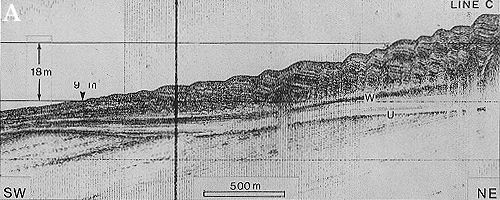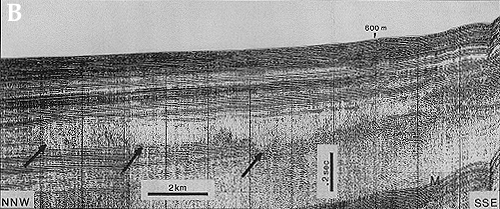

Submarine slides: morphology and geometry
Plate 130


Submarine slides: morphology and geometry
Plate 130
Two seismic sections across the Italian continental margin in the Tyrrhenian Sea document the aspect of a Modern (A and an older (B) submarine slide. Record A was obtained by a 3.5 kHz Subbottom Profiler, record B by a 1 kJ Sparker source.
The Modern slide is indicated by the undulated topography of the sea bottom, which is also expressed in underlying reflectors. The undulations are related to the stepped profile of a body sliced by seaward dipping slip planes. The planes join a basal detachment surface (W). Almost horizontal beds lie below the slid mass, and an unconformity (U) separates them from clinoforms (or tilted beds) which represent the deepest levels penetrated by acoustic energy.
In B, the slide body appears as a structureless lens sandwiched between slightly dipping reflectors. The overlying ones have buried and "sealed" the slide. Their thickness (here expressed as a two-way travel time of acoustic waves: average sound velocity in Quaternary muddy sediments can be assumed as 1500 km/s) is considerable, suggesting that the slide is relatively old. The reflectors underlying the slide are parallel and continuous in the distal area (first two arrows from the left), becoming more irregular in proximity of the slope to the right.
The seaward tip of the slide lens displays surficial undulations and internal discontinuous, "chaotic" reflectors, while the rest is apparently structureless or "transparent". Such aspect is due to the disordered internal structure, which diffuses acoustic energy (compare with plate 2). This means that the deformation is intense and pervasive. The basal slip surface (see arrows) is more irregular than in section A. The upslope tip of the chaotic lens, to the right, joins an ill-resolved detachment zone, from which another slide of smaller size originated after the large one (see lens beneath the "600 m" spot). M is a multiple echo of superficial reflectors.
| Photo: F. Trincardi, Institute for Marine Geology, C.N.R. 1992. |